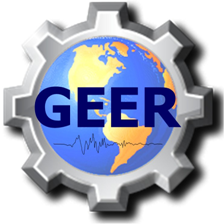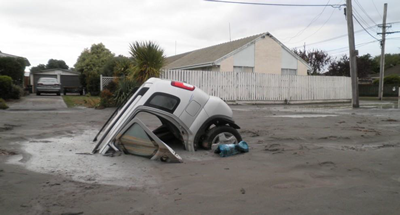 12 March 2014 – A team from the Geotechnical Extreme Events Reconnaissance (GEER) Association, supported by the National Science Foundation, has been mobilized to investigate the potential impacts of the wide spread liquefaction as a result of the 2010 – 2011 Canterbury earthquake sequence on the recent Christchurch, New Zealand flooding that occurred 6 – 8 March 2014. They will work closely with New Zealand engineers and scientists who have already documented many of its effects.
12 March 2014 – A team from the Geotechnical Extreme Events Reconnaissance (GEER) Association, supported by the National Science Foundation, has been mobilized to investigate the potential impacts of the wide spread liquefaction as a result of the 2010 – 2011 Canterbury earthquake sequence on the recent Christchurch, New Zealand flooding that occurred 6 – 8 March 2014. They will work closely with New Zealand engineers and scientists who have already documented many of its effects.
GEER members and other earthquake professionals have been documenting the effects on the ground and infrastructure of Christchurch and its surrounding communities since the Darfield earthquake occurred on 4 September 2010.
Mr. John Allen, a professional engineer, is coordinating the investigation of the potential multi-hazards impacts of the 2014 flood event in relation to the 2010 – 2011 Canterbury earthquake sequence.
Advancing performance based engineering for infrastructure requires that we understand changes that result from the widespread liquefaction that occurred in Christchurch and its relationship to future extreme events. Also participating in the investigation are Dr. Craig Davis (City of Los Angeles, Department of Water and Power), Dr. Laurie Johnson (Laurie Johnson Consulting), Dr. William Siembieda (Cal Poly San Luis Obispo), Dr. Nina Stark (Virginia Tech), and Dr. Rebecca Teasley (University of Minnesota Duluth). These engineers
and scientists will work with New Zealand experts to compile as much data as possible and document both failures and performance of infrastructure during the flood event.

The City of Christchurch and surrounding communities experienced a series of large earthquakes in 2010 and 2011. During these events there had been widespread liquefaction and lateral spreading damage in the western suburbs and along rivers that run throughout the city. Reconstruction and repair to the city’s infrastructure began within hours of each event and continues today. The team will be focusing on understanding how a large liquefaction event impacts the damaging effects of another extreme event that follows it. The team will be focusing on critical infrastructure performance such as sewer and water networks, foundations of critical structures, levee networks, and other lifelines. In addition, the team will be investigating how the changes in the surface topography from one extreme event potentially impact the severity of another type of extreme event.
The recent flood in Christchurch provides a unique opportunity to investigate two different extreme events that occurred within a relativity short period of time to each other and to investigate if the first event possibly impacted the severity of the second event. Extreme events engineering is an experience-driven field in which perishable data that can be used to advance our understanding should be systematically collected immediately following the event. The team collects data using a variety of tools. The team will collaborate with local engineering practitioners and scientists. Documenting this extreme event and making the key lessons learned publicly available contribute significantly to advancing research and practice in engineering.
After the field investigation is complete, observations and findings will be posted on the GEER website.
Additional information on GEER is available at: www.geerassociation.org.
**
GEER Contact: John M. Allen, P.E., TRI Environmental, 512-705-5657, jallen@tri-env.com











